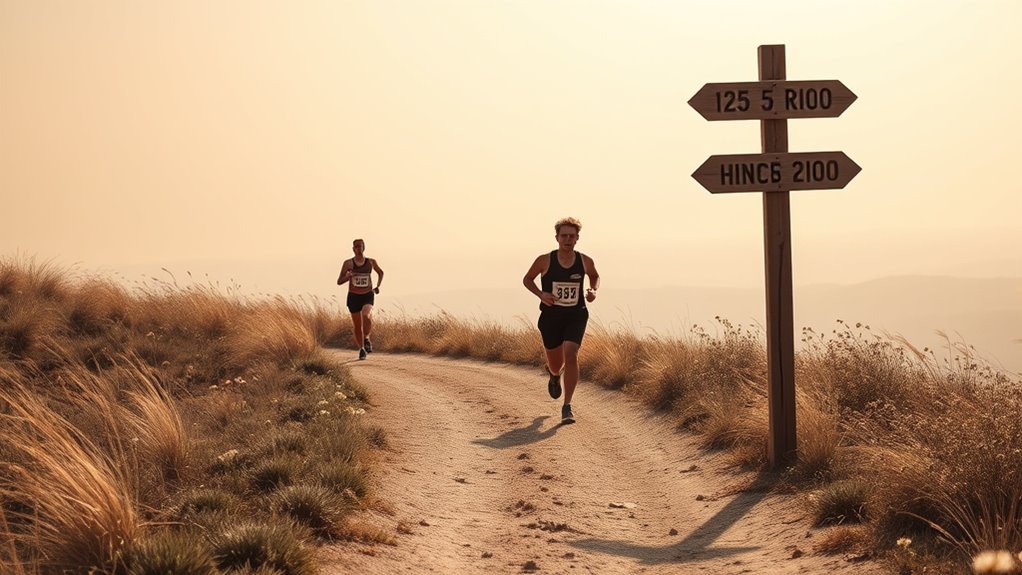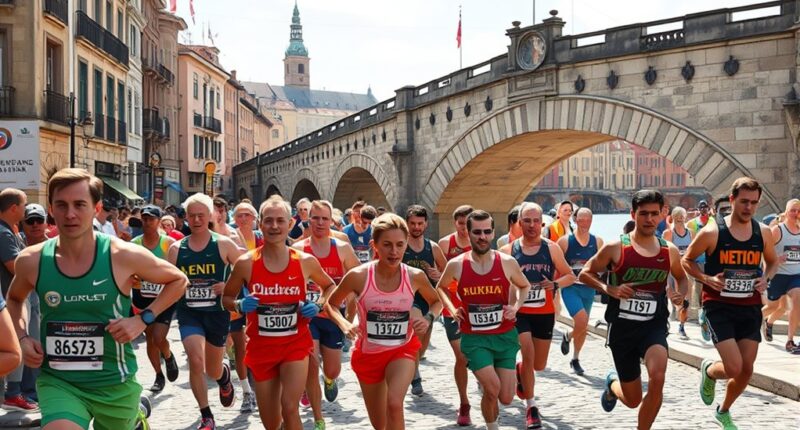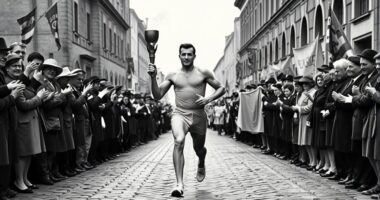The half marathon started over a century ago as informal races derived from the classic marathon, offering a challenging yet manageable distance. As organized long-distance races gained popularity in the 1970s and 1980s, the half marathon gained recognition, attracting diverse participants worldwide. Advances in training, technology, and global events helped it grow into a celebration of endurance and community. If you explore further, you’ll discover how this event continues to evolve and inspire runners everywhere.
Key Takeaways
- The half marathon has origins over a century ago, evolving from long-distance running traditions and community races.
- It emerged in the early 20th century as runners sought a challenging distance shorter than the marathon.
- Organized races in the 1970s and 1980s helped standardize and popularize the half marathon worldwide.
- Advances in training, technology, and sports science have improved performance and increased its global appeal.
- Today, it is a major international event symbolizing endurance, community, and personal achievement across diverse populations.

The half marathon, a popular race distance of 13.1 miles, has a history that traces back over a century, blending tradition with modern athleticism. Its race origins are rooted in the evolution of long-distance running, which gained popularity in the early 20th century as both a competitive sport and a demonstration of personal endurance. Initially, marathon races dominated the scene, but as athletes pushed beyond the traditional 26.2 miles, the idea of a shorter, equally challenging race emerged. This middle ground became the half marathon, offering runners a manageable yet demanding challenge that fit well into the evolving landscape of athletic competition.
In the early days, the concept of a half marathon was less formalized, often emerging from local races or community events. As running gained momentum, especially with the rise of organized marathons in the 1970s and 1980s, the half marathon started to carve out its own identity. It became an accessible option for recreational runners who wanted a substantial challenge without the exhaustive commitment of a full marathon. Over time, race organizers began standardizing the distance, creating a consistent and recognizable event for runners worldwide.
The athletic evolution of the half marathon is closely tied to advancements in training, technology, and sports science. As athletes sought to improve their performance, training methods became more sophisticated, incorporating interval workouts, specialized nutrition, and injury prevention techniques. This progression allowed runners to push their limits further and achieve faster times, fueling the race’s popularity. Technological innovations, like improved running shoes and timing systems, also contributed to the race’s growth, providing runners with tools to optimize their performance and track their progress.
Throughout its history, the half marathon has transformed from a niche event into a global phenomenon. Major city races now attract tens of thousands of participants, from elite athletes to casual joggers, all enthusiastic to experience the challenge. The race origins and athletic evolution of the half marathon showcase how a simple idea—splitting a marathon into two manageable parts—grew into a dynamic, inclusive race that celebrates endurance, community, and personal achievement. Today, it stands as a tribute to how tradition and innovation continue to shape the sport of running, inspiring countless individuals to lace up and chase their goals. The evolution of long-distance running continues to influence how races are designed and celebrated worldwide.
Frequently Asked Questions
When Was the First Official Half Marathon Race Held?
You’ll find that the first official half marathon race was held in 1908 at the London Olympics. Its history origins trace back to the development of marathon distances, which inspired the creation of shorter race formats. Over time, this race development gained popularity, and the half marathon became a standard competitive event. Today, it’s celebrated worldwide, blending tradition and athletic challenge, making it a favorite for runners of all levels.
Who Is Considered the Father of the Modern Half Marathon?
You’d consider George Oldfield the father of the modern half marathon. As a legendary pioneer in race organization, he helped popularize the event in the 1960s. His efforts in standardizing distances and promoting the race inspired countless runners and organizers worldwide. Oldfield’s contributions laid the foundation for today’s half marathon, turning it into a celebrated and widely accessible race that continues to grow in popularity today.
What Are the Most Common Training Methods for Half Marathon Runners?
You might think running alone is enough, but the most effective half marathon training includes interval training and cross training. Interval training boosts your speed and endurance, pushing you past your limits. Cross training, like cycling or swimming, reduces injury risk while building overall strength. These methods keep your training dynamic and exciting, helping you stay motivated and prepared to conquer race day. Don’t underestimate the power of variety in your training plan.
How Has Technology Influenced Half Marathon Training and Racing?
Technology has revolutionized your half marathon training and racing by enabling you to use wearable technology like GPS watches and heart rate monitors, which track your progress and optimize your workouts. Virtual races allow you to compete from anywhere, making training more flexible and engaging. These innovations help you monitor performance, stay motivated, and connect with a global running community, ultimately improving your race experience and outcomes.
What Are Some Notable World Records in Half Marathon History?
You’ll find that elite performances in the half marathon have shattered records, like the men’s world record set by Jacob Kiplimo at 57:31 in 2021. Women’s records also impress, with Ruth Chepngetich running 1:04:02 in 2021. These record-breaking feats showcase the incredible progress athletes make, pushing the boundaries of human endurance and inspiring new generations to chase their own extraordinary achievements in this demanding race.
Conclusion
Now that you know the half marathon’s origins, imagine yourself crossing the finish line after months of training. Like Sarah, who started running for fun and ended up completing her first half marathon, you too can experience that incredible sense of achievement. Whether it’s for health, challenge, or community, the half marathon offers more than just a race — it’s a journey worth starting. So, lace up your shoes and take that first step today.








